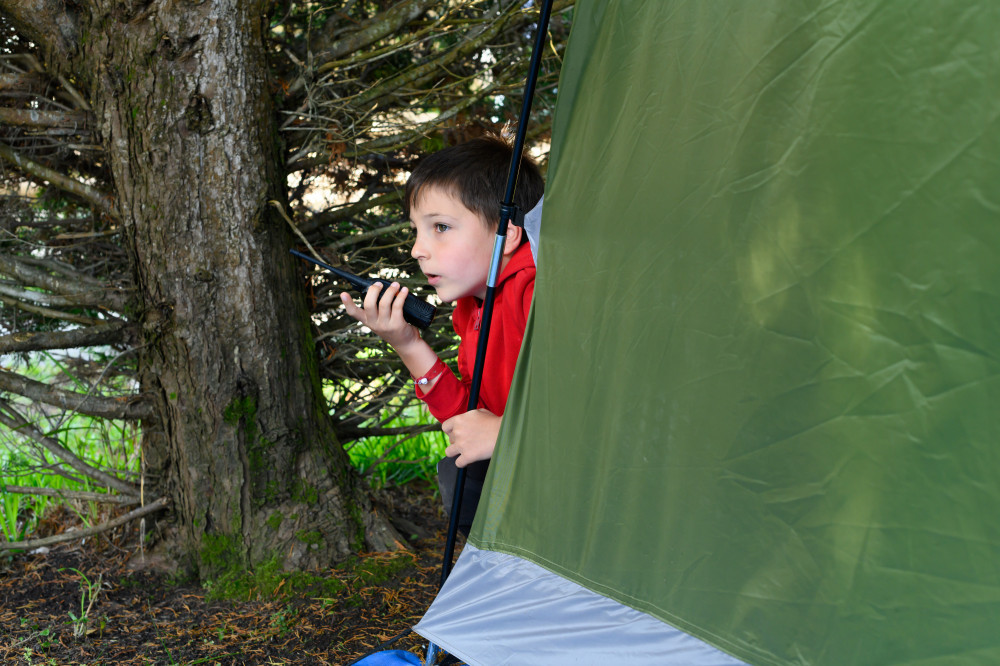Whether you are spending time in nature hiking and camping, being off the grid for a while, or even taking a road trip, a set of walkie-talkies will make keeping in touch with others much easier when you are without cell phone service. The best walkie-talkies, or two-way radios, will keep you in touch with your party, as well as offering the added security of furnishing you with weather alerts and other important emergency features.
RANGE AND CLARITY
Two major features to consider when searching for the perfect walkie-talkie should be the range and clarity of the radio. These features are extremely important because if you are not able to send or receive messages clearly over your intended distance, there is not much use for that particular walkie-talkie at all.
This article actually came into being because of that exact problem! My husband and I have purchased walkie-talkies in the past for use on our property – a heavenly spread of 35 wooded, hilly acres in Kentucky, and we have never had a set that performed well at all when and where we needed them to. With Christmas coming up very soon, I have decided to give walkie-talkies another try. I have been doing lots of research on exactly how these devices work, and how to find the very best two-way radios that will actually perform when and where they are needed the most. If you are in the same boat, or know of someone who is, this particular article has been created for my use just as much as yours, and I truly hope this will help us all to make much wiser decisions when purchasing an incredible walkie-talkie. Now, let’s dig into this research!
As an Amazon Associate, I earn from qualifying purchases. Thank You!
Most manufacturers will give you a maximum range of their walkie-talkie’s range distance, usually stating the range somewhere between 20 to 35 miles. This range is based on “ideal conditions”, which consists of people communicating in a direct path with no obstacles between them, on a perfectly clear day. In real life situations, these ideal conditions are not met very often, so right off, you can expect the walkie-talkie to receive maybe half of the manufacturer’s “ideal range” specifications.
In reality, a walkie-talkie’s maximum range will be determined by a variety of factors. The three most important factors are the radio’s output power, transmission frequency, and it’s antenna type and size.
Almost all U.S. Consumer walkie-talkies fall under two categories which are regulated by the Federal Communications Commission, or FCC.
The most popular category is the Family Radio Service (FRS), which does not need a license to operate, uses a standard set of 22 channels, has a maximum of 2 watts of power, and has a fixed antenna. In this article, I will focus on the license-free, FRS radios.
There is also the General Mobile Radio Service (GMRS), which does require a license to operate, offers more channels, and has a maximum of 5 watts of power, which may give them a greater range in some situations.
The many manufacturers of FRS radios all claim different maximum ranges, between 20 to 35 miles. Remember, all of these walkie-talkies operate under the same regulations, and this is what limits their transmission frequency and output power. You can expect radios with the same amount of output power to have pretty much the same range distance as their competitors, especially after you consider the “ideal range” factors.
Now that we understand “ideal range”, it is time to determine the actual “usable range” of a walkie-talkie. The usable range of a radio is constrained by many factors. These include weather, the geometry of your surrounding landscape, any obstructions and elevation within this landscape, and any noise from other radios in the area.
The biggest concern in obtaining a radio’s usable range will be the geometry of the landscape surrounding you along with any obstacles within this landscape.
When considering the geometry of the landscape, we must factor in the UHF Spectrum. The FCC limits FRS license-free walkie-talkies to the Ultra-High Frequency (UHF), which travels in a straight line until it bounces off obstacles or it is absorbed by objects. This results in UHF radios being “line-of-sight” devices. You will be able to obtain signals around bends, but we must realize that radio waves need to bounce to reach us, which greatly reduces their power.
UHF radio waves will be weakened or blocked by obstacles in the landscape. Objects like trees will limit radio range, while obstacles like hills or mountains will totally block radio transmission.
Now that we know how radios work, we have a much better understanding of their abilities and limitations when it comes to their actual range distance. It is now time to focus on a walkie-talkies’s attributes for durability, weather alerts and other safety functions that could literally save your life!
DURABILITY
Walkie-talkies offer a durability rating called an International Protection Rating, for each radio. When checking waterproof radios for durability, you will look for the IP Rating. In this instance, the IP also stands for Ingress Protection, or the level of protection provided by the radio enclosures. The first number after the IP stands for “Solids Protection”, which includes fingers, hands, and dust. The second number stands for “Liquid Protection”, and includes moisture of varying kinds and degrees.
The highest waterproof protection will be the number 8, and the highest solid protection will be the number 6. Using this example of a radio with a rating of IP68, this device would be completely protected against dust and also long term immersion up to a certain pressure, literally the very best device you could purchase.
It is important to remember that any electronic device is more water resistant than waterproof, as any electronic device will eventually succumb to damage if submerged for too long in water, or under a too great amount of pressure.
CHANNELS
Walkie talkie channels are basically a means to divide radio frequencies, which helps prevent different groups of people from reaching the wrong group of contacts. The channels work in a similar fashion as an old landline telephone having a private line versus a party line.
Two-way radios receive and transmit signals on different channels and frequency bands represented as Hertz, or hz. FRS and GMRS are radio frequencies available for public use in the United States.
Walkie talkie handsets use roughly 22 channels with set corresponding power outputs to communicate. Having a device with a greater number of channels helps to prevent people from talking over each other. They perform in 2 frequency bands – Ultra High Frequency (UHF), and Very High Frequency (VHF).
One very important capability your walkie-talkie should have is access to the National Oceanic and Atmospheric Administration (NOAA) Weather Channels. If your device offers this feature, the radio will automatically scan the NOAA channels, and alert you to any weather alerts in your area.
The very best walkie-talkies offer both VHF and UHF bands. A dual-band device will have more channels and is able to cover both short and long distances. These radios have FRS and GMRS capabilities, and offer 22 channels with varying degrees of power output. When the device is set to the FRS channels (1-14), it offers a reach up to 2 miles. If a longer reach capability is needed, switch over to the GMRS channels (15-22).
OTHER IMPORTANT FUNCTIONS
There are a few other very important functions your walkie-talkie should offer to give you greater peace of mind whether you are on the trails, in the wilderness, or just in your own back yard. Your device should offer a long battery life, have USB charging capability, and a flashlight. Also, look for a radio with an SOS siren. This is one function you definitely do not want to overlook as it could literally save your life!
I hope you have received some useful information from my article, and you will be much more knowledgeable and informed when it is time to look for a walkie-talkie for your next adventure! Keep your group’s communication lines open, connected, and ready to converse!!










Thank you for sharing your experience with us. The range is crucial in the areas where we hike. And it could even be life-saving. So bearing into consideration that walkie-talkie manufacturers set this number thinking in “ideal conditions” is important.
There is nothing worse than needing help and the walkie-talkie not working.
Hi Paulo!
Thanks for your comment on my article, and I am very glad you got something out of it. Yes, it is very important to know exactly what type of service we can expect when we purchase walkie-talkies, especially when we consider their life-saving abilities. Stay safe on the trails, and happy hiking!!
Nettie
Thank you for your kind comment – I am glad you enjoyed my post! Please continue to check out my website as I am in the process of adding more posts in the next few weeks! Feel free to leave any comments, opinions, or questions, and I will get back with you as soon as possible! Have a great day!!
Thank you for your kind comment on my post – I am glad that you received some useful information! I would like to invite you to check out my website often as I am constantly adding new articles. Have an awesome day!!
Thank you for your kind comment on my post – I really appreciate it! I would like to invite you to check out my website often as I am constantly adding new posts. Have an awesome weekend!
Hello and thank you for your kind comment on my post – I appreciate it very much! I would like to invite you to check out my website often as I am constantly adding new posts. Have a wonderful weekend!
Hello, and thank you for your comment on my article! Please check back on my website, https://lets-take-a-hike.com, often, as I am adding new articles often!
Hello and thank you for your kind comment on my post – I truly appreciate it! I would like to invite you to check out my website often as I am constantly adding new posts. Thank You, and have a great weekend!
Hello and thank you for your kind comment on my post! I would like to invite you to check out my website often as I am constantly adding new posts. Have a great weekend!
Good Morning, and thank you for your kind comment on my post! I am very glad that you found some useful information in my article! I would like to invite you to check out my website often as I am constantly adding new posts. Have a wonderful day!
Nettie
Good Morning and thank you for your kind comment on my post! I am glad that you found some useful information! I would like to invite you to check out my website often as I am constantly adding new posts. Have a wonderful day!
Nettie
Good Morning and thank you for your kind comment on my post – I am glad you found some useful information! I would like to invite you to check out my website often as I am constantly adding new posts. Have a great day!
Nettie